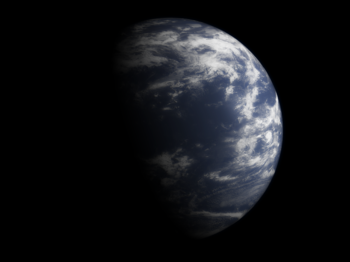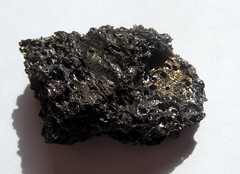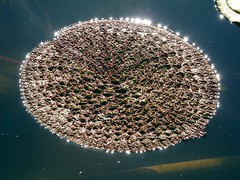November 20, 2013
Greetings from Double-Earth
A question came up on the Extropians list about what a planet twice as large as Earth would be like. Being an obsessive worldbuilder that has been reading too much exoplanet papers recently I jumped at the question, of course.
(This is not going to be super-exact, just good enough to get a sense of the environment.)
Structure

A first complication: "twice as large" is not the same thing as double the mass. A double-mass Earth is relatively simple to analyse, but if we stipulate that the radius is twice as big, then it depends on what it is made of.
A lot hinges on whether we assume Double-Earth started out beyond the iceline of the solar system and moved inwards, in which case it will be really wet, or started out close to the sun and never got much volatiles. In the first case, "Wet Double-Earth" the mass will be about 3 Earths and the average density 37% of Earth, with a surface gravity of 0.73 g and an escape velocity of 13.6 km/s. This will have an ocean hundreds of kilometres deep, surrounding a rocky core covered with high pressure warm ices. In the second case, "Dry Double-Earth", the mass will be 15 Earths, the density will be 167%, gravity 3.4 g and escape velocity 30 km/s. (I used the model of Sotin et al. in Sotin, C., Grasset, O., Mocquet, A. 2007. Mass-radius curve for extrasolar Earth-like planets and ocean planets. Icarus 191, 337-351.)
Note that if the component rock contributes water like on Earth, a planet with 15 times the mass but only 4 times the area will have 3.75 times deeper hydrosphere, assuming everything equal. That means 16 km deep oceans - "Dry" might still be a waterworld.
How large is the core of Wet? Assuming it to be Earth density (5520 kg/m^3) and surrounded by water (1000 kg/m^3) I get a core 1.22 times the radius of Earth (7,772 km), surrounded by 0.78 Earth radii of water (4,969 km). This is of course just a first approximation, since there is a high pressure ice crust that begins when pressures go above 1 GPa. A bit more calculation gives me an estimate o a 6,060 km core (0.95 Earth) with an ice VI/VII crust out to 12,600 km (1.97 Earths), leaving "just" a 160 km deep ocean. If the deep ocean is colder the depth might be just 104 km.
Atmosphere
 Now we need to make some guesses at atmosphere and temperatures. The basic temperature for a greybody with Earthlike albedo at this orbital distance (1 AU around a sun-like star) is 250 K, if we add the 36 K greenhouse correction of Earth this becomes 13 degrees C average.
Now we need to make some guesses at atmosphere and temperatures. The basic temperature for a greybody with Earthlike albedo at this orbital distance (1 AU around a sun-like star) is 250 K, if we add the 36 K greenhouse correction of Earth this becomes 13 degrees C average.
There is another equilibrium similar to "snowball Earth" where the entire surface is cold and glacial (and ocean worlds can of course get *completely* iced over), reflecting away energy efficiently. For albedo 0.8 we end up with an temperature of -15 C. Of course, the vast oceans will in any case stay liquid, especially since the freezing point of water decreases beyond a few megaPascals of pressure.
In the wet case the scale height is 11.3 km - air pressure will be 36% less at this altitude. The temperature needed for a molecular species to escape is 1.49 times that on Earth: in this case hydrogen certainly escapes and I think helium will escape (it depends on the exosphere temperature, something that is hard to calculate). Methane and ammonia could be retained, but if there is life and oxygen they will have been turned into carbon dioxide and nitrogen.
In the dry case scale height is 2.4 km: clouds will be squat and close to the ground. The retention temperature is 7.5 times Earth - Dry could potentially retain hydrogen gas. This means that potentially it could have gathered a much denser atmosphere from the beginning, potentially turning into a gas giant. Note however that by assumption we had it form in the "dry" zone near the star, so it might not have accumulated that much. We should still expect it to have a denser atmosphere than the wet case.
If we make the assumption that the surface pressure is proportional to surface gravity (might make sense in this particular case) Wet has surface pressure 0.73 and Dry surface pressure 3.4 atmospheres.
In this case Wet gets air density 0.9 Earths. Quite manageable for humans.
 Let's also assume the mean wind speed is a terrestrial 10 m/s - again, this is hard to evaluate without running a full circulation model. Finally, most doubtfully, let's assume the rotation period is 24 hours. The radiative timescale of 18 days and advection timescale of 14 days - this means that the weather is complex like on Earth, and responds rather quickly to seasons (ah, I implicitly assumed an Earth-like axial tilt: things will get really strange if it is more extreme). Wet will have about 9-10 jet-streams (Earth has about 7). Dry instead has surface air density is 4.3 times Earth, fast timescales and 10 jet streams. Not too alien.
Let's also assume the mean wind speed is a terrestrial 10 m/s - again, this is hard to evaluate without running a full circulation model. Finally, most doubtfully, let's assume the rotation period is 24 hours. The radiative timescale of 18 days and advection timescale of 14 days - this means that the weather is complex like on Earth, and responds rather quickly to seasons (ah, I implicitly assumed an Earth-like axial tilt: things will get really strange if it is more extreme). Wet will have about 9-10 jet-streams (Earth has about 7). Dry instead has surface air density is 4.3 times Earth, fast timescales and 10 jet streams. Not too alien.
Weather is partially driven by buoyancy. On Wet this is weaker: clouds will be taller and move more ponderously, while on Dry the higher gravity will make small density differences generate more force: flatter, more intense convection.
Coriolis forces are twice as powerful, so there is a higher tendency for zonal rather than meridional winds: more east-west flow than north-south than on Earth.
A rain cloud will have an amount of water roughly proportional to its height and the atmospheric density: both Wet and Dry will have more rain from a typical raincloud than on Earth (about 30-40%, assuming my assumptions work), with Wet slightly wetter - the lower air density is compensated by a much higher scale height. In practice this will depend on more complex aspects of the atmosphere (lapse rates and similar stuff).
Hail on Wet may be truly nasty, since it has plenty of distance to form. The radius likely scales proportionally to the scale height, making the mass of large hailstones up to 3.5 times larger - the fact that they just weigh just 2.6 times more thanks to the lower gravity is not enough. Terminal falling velocity scales as sqrt(gravity/density), so the velocity of a hailstone will be just 90% of terrestrial terminal velocity of a same sized stone. On Dry it is 89% thanks to the thicker air. But this is not enough: the kinetic energy will be about three times larger. Ouch.
The strength of hurricanes depends on the temperature difference between the ocean and the stratosphere; I do not know how to calculate this simply. I note that in the absence of land they can run much longer before drifting too far towards the poles that they dissipate. If the zonal winds are strong enough hurricanes may even become semi-permanent like the red spot on Jupiter, but I suspect there is enough meridional winds to prevent this.
I am also a bit uncertain about whether latitudinal mixing is strong enough to keep the poles too warm to form ice sheets or not. I suspect the lack of land and the presence of a huge ocean thermal capacity will reduce ice formation.
If we assume 20% oxygen, then Dry will have 537 mmHg partial pressure oxygen - toxic to humans. Even worse, the partial pressure of CO2 will be 10.4 mmHg - causing hypercapnia in humans. Still, local life could likely evolve to handle that with little problem. Wet atmosphere looks pretty OK for humans.
The optical depth of the atmospheres on the Double-Earths will be the same as on Earth (because of my assumption of pressure = surface gravity), so you can see the same distance. The vertical optical depth is 1.37 times more than Earth on Wet: the sky is more milky, but not too alien. On Dry it is just 1.1: almost normal. If you were to fly a plane, it would however turn dark blue at a much lower altitude.
Geosphere
 The radiogenic heating (assuming an Earthlike composition) of Dry is 3.34 times higher than on Earth, 0.29 W/m^2. Still not enough to melt the crust into an Io-like volcanic mess, but it is far more active - the crust is just 3 kilometers thick. Underwater volcanos are common, and there will be plentiful hydrothermal vents. The higher strength of buoyancy makes volcanism-induced convection more powerful: the deep ocean will be churned far more than Earth's deep ocean by geothermal heat.
The radiogenic heating (assuming an Earthlike composition) of Dry is 3.34 times higher than on Earth, 0.29 W/m^2. Still not enough to melt the crust into an Io-like volcanic mess, but it is far more active - the crust is just 3 kilometers thick. Underwater volcanos are common, and there will be plentiful hydrothermal vents. The higher strength of buoyancy makes volcanism-induced convection more powerful: the deep ocean will be churned far more than Earth's deep ocean by geothermal heat.
If Dry had a sufficiently eccentric orbit (or a heavy companion) to give it extra tidal heating volcanism might be fierce enough to create an Io-like state of semi-molten crust. At this point it would likely become very different: the churning oceans would accumulate significant amounts of minerals, including lots of sulphur. A world with sulphuric acid oceans might be the result. Life might still be possible, but it would likely have to be based on more robust biochemistry. However, acid-Dry would also have to deal with plentiful carbon dioxide emissions that make the greenhouse effect stronger. Adjusting parameters to keep it in the life zone (if it is even possible) would be a bit of work. [Thanks to Andrew Snyder-Beattie for this fun possibility]
Wet has slightly more radiogenic heating than Earth (1.22 more). This is enough for continental drift (hence churning the deep ice crust). However, that direct churning is unlikely continue out to the ice surface. The energy flow at the ice surface is just 0.02 W/m^2 - not enough to drive continental drift on a rock planet, but maybe enough for some ice dynamics.
Mountains on Wet will tend to be 1.37 times taller than on Earth, but they will all be on the bottom of the super-deep ocean. On Dry they will be just 0.29 times the height - the local Mount Everest will be just 2.4 km. Given my guess at mean ocean depths, this means that it will indeed be a waterworld.
If one buys the idea that Coriolis-Lorenz dynamos in the core scales as sqrt(density/period) the magnetic field of Wet will be 100% of Earths, while Dry 130% - not an enormous difference.
Hydrosphere
 On the oceans, waves would be moving differently. On Wet they would move at 85% of Earth speed, while on Dry 184%. The height would of course scale inversely with gravity: 136% on Wet, but just 29% on Dry. So the seas would be choppier but slower in the wet case (but the waves will have more energy per square meter), while the dry case would have fast low swells.
On the oceans, waves would be moving differently. On Wet they would move at 85% of Earth speed, while on Dry 184%. The height would of course scale inversely with gravity: 136% on Wet, but just 29% on Dry. So the seas would be choppier but slower in the wet case (but the waves will have more energy per square meter), while the dry case would have fast low swells.
Light would penetrate the water just like on Earth on both worlds, with a lit zone about 200 meters deep where photosynthesis could work.
The extensive hydrospheres would tend to act as massive thermal buffers, resisting temperature changes due to day/night cycles and seasons.
Ocean currents are powered by trade winds: as the air convects around the equator and is deflected by the Coriolis effect into trade winds, some of the wind energy is transmitted to the water. This produces currents like in the central pacific: a northern and southern equatorial current flowing westwards, and between them a east-flowing counter-current. Further north there might be circular gyres, or perhaps other east-west current bands. If the currents are mainly east-west the temperature difference between equator and poles will be larger, driving a deep convection where colder water descends in the polar areas and ascends near the equator. Away from the equator there will also be deep Ekman currents down to about 100 meters, creating a more complex circulation.
The oceans will tend to be stratified, since less dense warm water overlies denser colder deep water (even the volcanic Dry has much less heat flux from beneath than from above). Some surface layer convection driven by winds and evaporation-driven salinity differences will occur, but deeper layers stay where they are. Polar water may go all the way down, at least on Dry. But there are no undersea mountains mixing layers or places where deep currents are forced up by continents. There will be some upwelling in the Intertropical Convergence Zone along the equator, which at least on Dry might be the main source of nutrient rich deep water. On Wet the ocean is so deep that the wind-driven forcing will not penetrate very far, and the upwelling will be less useful.
Volcanism might be the main factor causing upwellings of mineral-rich really deep water: even a mild temperature difference is enough to send up a thermal plume. Note that plumes ascending from very deep will be affected by Coriolis forces. This already happens on Earth, but on Wet the effect would be far stronger since they travel an appreciable fraction of the planetary radius. As they move upwards they are deflected westwards, and acquire spin if they are away from the equator.
In general, the oceans will be less salty than on Earth since there are no continents to be leached by pure rain - the only salts dissolved will come from volcanism and slow equilibration with exposed crust. Wet will be particularly fresh - there is no direct water contact with the crust, and the total water volume is many times larger than on Dry.
Biosphere
 Both Dry and Wet could have a surface biosphere functioning like an open sea biosphere on Earth. Photosynthesis among algae would be the foundation of the nutrient web, with various forms of plankton and larger organisms harvesting them and each other. Like on Earth, most biomass would be in the lit surface layer with more scarce detritivores and predators lurking in the depths.
Both Dry and Wet could have a surface biosphere functioning like an open sea biosphere on Earth. Photosynthesis among algae would be the foundation of the nutrient web, with various forms of plankton and larger organisms harvesting them and each other. Like on Earth, most biomass would be in the lit surface layer with more scarce detritivores and predators lurking in the depths.
Just like in terrestrial oceans there is no real size limit to organisms due to gravity, just ecological limits (large animals need more food and take longer to mature, so at some point they hit diminishing returns of food-gathering capacity and survival probability to reproduction). Vertical surface plants (for example growing of rafts of organic matter, or shoots sent up by floating plants) will be much a third shorter on Dry than on Earth due to gravity considerations.
The bottom region can have hydrothermal vent ecologies like on Earth. On Wet hot water needs to penetrate a thick ice crust, making their exact structure (or possibility) dependent on issues of how hot high pressure ice behaves - I do not have a real clue here. An intriguing possibility might be counterparts to earthly lithoautotrophs living inside fissures in the ice crust. On Dry things are fairly terrestrial.
Note that there is no real need for oxygen to maintain this kind of ecosystems: on Earth they exploit available oxygen, but with enough volcanic chemical flow you can sustain life in other ways. For example terrestrial anammox bacteria turn ammonia into nitrogen using nitrites instead of ocygen, Thiobacillus denitrificans turn sulphur into sulphates using nitrates, hydrogen bacteria turn hydrogen into water using sulphates, phosphite bacteria convert phosphite into phosphate using sulphate, metanogens turn hydrogen into water using carbon dioxide, and the carboxydotropic bacteria convert carbon monoxide into carbon dioxide while turning water into hydrogen.
The lack of salts on Wet is going to be a major problem for local life. Assuming Earth-style life most of it is going to be built out of CHON, but it needs to pick up other elements for special purpose enzymes and molecules. Most likely it will employ structures that catch the rare heavier atoms needed, like terrestrial siderophores. Cells will also have an osmosis problem: if their concentration of solutes is higher than seawater (useful in order to keep reaction rates up) water molecules will seep in, threatening the cells with bursting. They need to continually pump out water to maintain stability (at an energy cost), very much like freshwater organisms. Osmoconformers that maintain the same concentration as on the outside will have largish cells with slow reaction rates.
While the surface will be four times Earth's on both Double-Earths, it will be well mixed so that there will be fewer species. Dry at the very least can run two near-independent ecosystem layers plus some stuff in-between. Intelligence evolution... well, who knows.
Summary
Both Double-Earths are waterworlds, but one is *deep*. Neither has any land. Both might have interesting deep sea vent ecologies, the wet case around vents in the high pressure ice and the dry case more terrestrial-style vents. Wet might turn stagnant in the depths relatively quickly, though. On the surface the ocean has weather like on Earth, either strangely tall or fiercely squat clouds. Life could probably thrive on both worlds, but would be limited by minerals: no land, no surface weathering, and hence less minerals added to the oceans. Getting into space from Wet is about as tough as on Earth, while Dry is pretty hard to get away from.
Thanks to Kelly Anderson for initiating the discussion and Tomaz Kristan for a comment.
Posted by Anders3 at November 20, 2013 12:55 PM